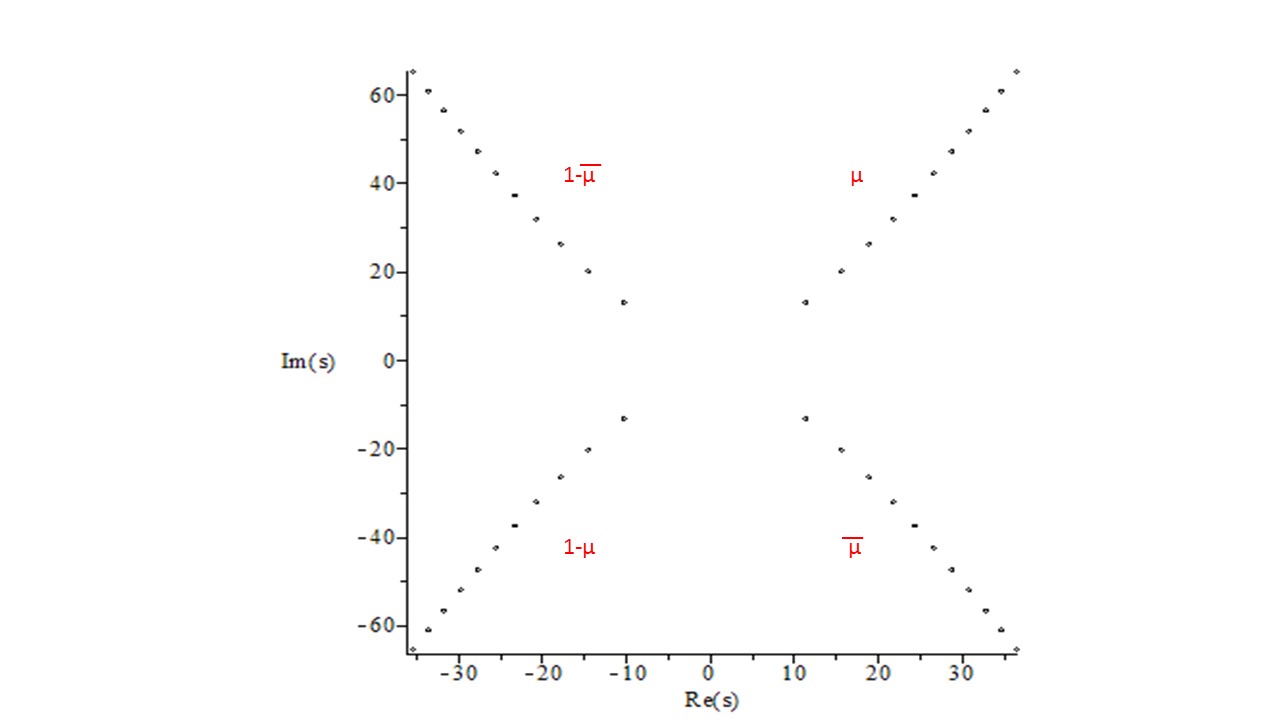I have deleted a previous, now obsolete questionquestion on the same topic.
Take the well-known Riemann integral:
$$\displaystyle \pi^{-\frac{s}{2}}\,\Gamma\left(\frac{s}{2}\right)\, \zeta(s) =\int_1^{\infty} \left({x}^{\frac{s}{2}-1} + {x}^{-\frac{s}{2}-\frac12}\right)\,\sum_{n=1}^{\infty}e^{-\pi\,n^2\,x}\, \text{d}x - \frac{1}{s\,(1-s)}$$
and move $\frac{1}{s\,(1-s)}$ to the RHS to make both sides entire and call it $\widehat{\xi}(s)$:
$$\displaystyle \widehat{\xi}(s)=\pi^{-\frac{s}{2}}\,\Gamma\left(\frac{s}{2}\right)\, \zeta(s) + \frac{1}{s\,(1-s)} =\int_1^{\infty} \left({x}^{\frac{s}{2}-1} + {x}^{-\frac{s}{2}-\frac12}\right)\,\sum_{n=1}^{\infty}e^{-\pi\,n^2\,x}\, \text{d}x$$
The function $\widehat{\xi}(s) = \widehat{\xi}(1-s)$ induces an infinite number of symmetrical zero ($\mu$) foursomes.

After calculating the first 100.000 $\mu$'s (i.e. 400.000 zeros), I strongly believe that $\widehat{\xi}(s)$ has the following Hadamard product ( ' denotes that also $\overline{\mu_n},1-\mu_n,1-\overline{\mu_n}$ should be included in the operation):
$$\displaystyle \widehat{\xi}(s) = \widehat{\xi}(0) \prod_{n=1}^{\infty}' \Bigl(1-\frac{s}{\mu_n}\Bigr)$$
Where $\widehat{\xi}(0)=\widehat{\xi}(1) = 1+\frac12\gamma -\ln(2)-\frac12\,\ln(\pi)$ which also equals $\sum_{ \rho }\Bigl( \frac{1}{\rho}+\frac{1}{1-\rho}\Bigr)$.
It then simply follows that:
$$\displaystyle \pi^{-\frac{s}{2}}\,\Gamma\left(\frac{s}{2}\right)\, \zeta(s) + \frac{1}{s\,(1-s)} = \widehat{\xi}(0) \prod_{n=1}^{\infty}' \Bigl(1-\frac{s}{\mu_n}\Bigr)$$
This allows equating the logarithmic derivatives $\frac{\widehat{\xi}'}{\widehat{\xi}}(s)$ of both sides and injecting $s=1$ gives:
$$\displaystyle \sum_{n=1}^{\infty}'\Bigl(\frac{1}{\mu_n}\Bigr)=\scriptsize{\frac{2\ln(\pi)^2+(8 \ln(2)-4\gamma)\ln(\pi)+8\ln(2)^2-6\gamma^2-8\gamma\ln(2)+\pi^2-16\gamma_1-16}{16+8\gamma-16\ln(2)-8\ln(\pi)}}$$
Also, the equation allows to express $\zeta(s)$ in terms of the $\mu$-zeros:
$$\displaystyle \zeta(s) = \dfrac{\widehat{\xi}(0) \prod_{n=1}^{\infty}' \Bigl(1-\frac{s}{\mu_n}\Bigr)-\frac{1}{s\,(1-s)}}{\pi^{-\frac{s}{2}}\,\Gamma\left(\frac{s}{2}\right)\,}$$
and the RHS induces a non-trivial zero $\rho$ when: $\displaystyle \widehat{\xi}(0) \prod_{n=1}^{\infty}' \Bigl(1-\frac{s}{\mu_n}\Bigr)=\frac{1}{s\,(1-s)}$.
Note that the zeros of $\widehat{\xi}(s)$ follow a surprisingly regular pattern. I believe this pattern originates from them all residing increasingly deeper in the domain $\Re(s)>1$. In this domain $\zeta(s)$ is well behaved and rapidly approaches $1$ when $\Re(s) \rightarrow \infty$. So, in $\pi^{-\frac{s}{2}}\,\Gamma\left(\frac{s}{2}\right)\, \zeta(s)$, the component $\zeta(s)$ will have a negligible influence on the location of the $\mu$'s. $\Gamma\left(\frac{s}{2}\right)$ can be expressed in terms of one of its Stirling approximation and the result follows that for $\Re(s) \rightarrow +\infty$, the function $\widehat{\xi}(s)$ will induce increasingly more accurate zeros $\mu$ and $\overline{\mu}$ when:
$$\displaystyle 2\,(s-1)\,\sqrt{\pi\,s}=\left(\frac{2\,e\,\pi}{s}\right)^{\frac{s}{2}}$$
Since $\widehat{\xi}(s) = \widehat{\xi}(1-s)$ the zeros $1-\mu,\overline{1-\mu}$ can be simply derived.
Question:
Assuming this Hadamard product can indeed be proven, does the apparent regular pattern of the $\mu$'s impose any constraint on where the non-trivial zeros $\rho$ of $\zeta(s)$ can reside in the critical strip (e.g. could it imply a zero-free region)?
